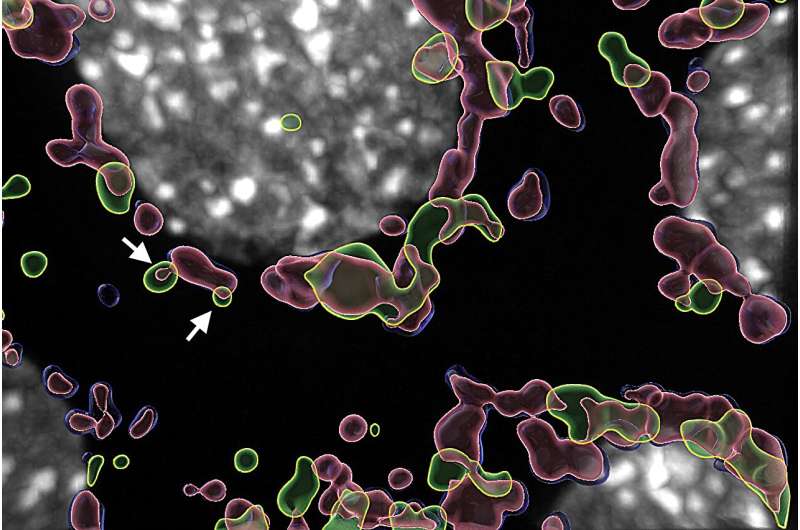
A 3D reconstruction showing the inner mitochondrial membrane (red) intercalating into a tightly connected lysosome (green). The outer mitochondrial membrane is shown in blue and the nucleus is shown in grey. Image credit: The Hospital for Sick Children (SickKids)
Mitochondria rely on a newly discovered recycling mechanism identified by scientists at the Hospital for Sick Children (SickKids).
Mitochondria are tiny structures inside cells that perform a variety of important functions, including producing energy to keep cells healthy. Each mitochondrion is made up of two layers of membrane: the outer membrane and the inner membrane. On the inner membrane are folds called cristae that contain proteins and molecules needed for energy production. When cristae are damaged, it can have negative effects on an entire cell.
“Our research shows for the first time that mitochondria are able to repair a local injury, remove damaged cristae and then function normally,” says Dr. Nicola Jones, staff physician and senior scientist in the SickKids Cell Biology Program and leader of the study, which is being conducted in Nature.
The research team believes that this mechanism is not only crucial for mitochondrial health, but could also be a future target for the diagnosis and treatment of diseases characterized by mitochondrial dysfunction, including infections, fatty liver disease, aging, neurodegenerative diseases and cancer.
The mechanisms of mitochondrial recycling
In cells, structures called lysosomes act as recycling centers that can digest various types of molecular material. Using state-of-the-art microscopes in the SickKids Imaging Facility, Dr. Akriti Prashar, a postdoctoral fellow in Jones’ lab and first author of the paper, found that the damaged crista of a mitochondrion can squeeze through its outer membrane, allowing a lysosome to directly enclose it and successfully disassemble it.
The researchers called the new process VDIM formation, an acronym for vesicles derived from the inner mitochondrial membrane. By removing damaged cristae through VDIMs, cells can prevent the damage from spreading to the remaining mitochondria and the entire cell.
“We believe that VDIMs could be a way to protect cells from health problems that affect mitochondria, such as cancer and neurodegeneration,” says Prashar.
A new process: VDIM formation
The research team, which included scientists from the Francis Crick Institute and Johns Hopkins University, found that the formation of a VDIM involves several steps and molecules. First, a damaged crista sends a signal that activates a channel on the nearby lysosome, allowing calcium to flow out of the lysosome.
Calcium then activates another channel on the mitochondrial outer membrane to form a pore and squeeze damaged cristae out of the mitochondria into the lysosome, which digests the damaged material – something never seen before. By recycling only the damaged crista, the mitochondria can continue their normal function.
“Understanding this process gives us insights into how mitochondria stay healthy, which is important for the overall health and longevity of all humans,” says Prashar.
Future research will investigate how altering VDIM formation could alleviate symptoms or even prevent health problems caused by underperforming or damaged mitochondria.
Further information:
Nicola Jones et al., Lysosomes lead to the gradual removal of the inner mitochondrial membrane, Nature (2024). DOI: 10.1038/s41586-024-07835-w. www.nature.com/articles/s41586-024-07835-w
Offered by the Hospital for Sick Children
Quote: Study shows that self-repairing mitochondria use a novel recycling system (21 August 2024), accessed 21 August 2024 from https://phys.org/news/2024-08-mitochondria-recycling.html
This document is subject to copyright. Except for the purposes of private study or research, no part of it may be reproduced without written permission. The contents are for information purposes only.

